
- Homepage
- Author
- Albion W. Tourgee (7)
- Benson J. Lossing (15)
- Edmund Kirke (6)
- Edward A. Pollard (8)
- Francis T. Miller (7)
- H V Boynton (11)
- J Thomas Scharf (8)
- Jefferson Davis (12)
- Julia S. Wheelock (14)
- Margaret Mitchell (19)
- Philip H. Sheridan (12)
- Rossiter Johnson (7)
- Shelby Foote (14)
- Stephen Crane (9)
- U. S. Grant (10)
- U.s. Grant (10)
- U.s.grant (11)
- Ulysses S Grant (7)
- Ulysses S. Grant (28)
- Various (11)
- ... (4093)
- Binding
- Language
- Publisher
- Appleton (5)
- Bunce & Huntington (6)
- Charles L Webster (6)
- Charles L. Webster (63)
- Charles Webster (14)
- D. Appleton (11)
- D. Van Nostrand (17)
- Donohue & Henneberry (6)
- E.b. Treat (6)
- G.p. Putnam's Sons (21)
- G.p. Putnams Sons (6)
- Harper & Brothers (31)
- Johnson & Bailey (9)
- Lange & Hillman (14)
- Macmillan (14)
- Mrs. Frank Leslie (6)
- Random House (11)
- S. Mcgerald & Sons (7)
- The Century Company (17)
- Time-life Books (11)
- ... (4038)
- Subject
- American History (7)
- Americana (72)
- Art & Photography (7)
- Bible (11)
- Civil War (56)
- Classic (4)
- Exploration & Travel (5)
- Fashion & Costumes (4)
- Figures & Portraits (18)
- General Interest (3)
- Historic & Vintage (10)
- History (233)
- Illustrated (6)
- Literature & Fiction (35)
- Men, Civil War (8)
- Military (12)
- Military & Political (130)
- Military & War (593)
- Reference (17)
- Science & Medicine (8)
- ... (3080)
- Year Printed
Antique CIVIL War Era Anti Slavery Abolitionist Suffragette Pa Ct Ny CDV Photos
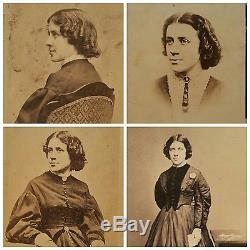
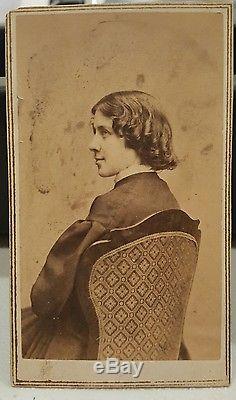
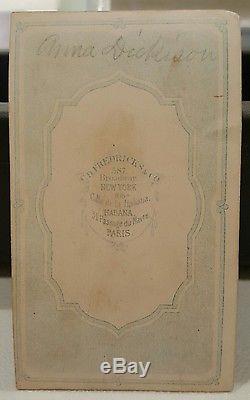
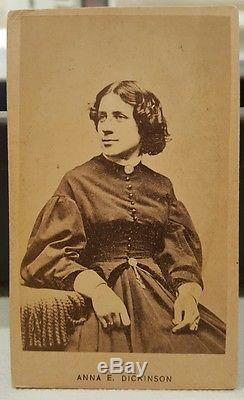

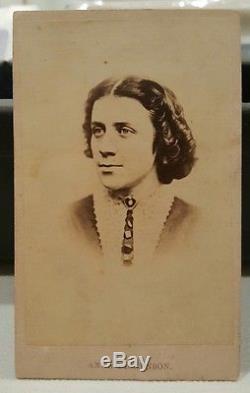

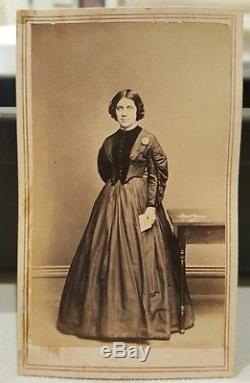
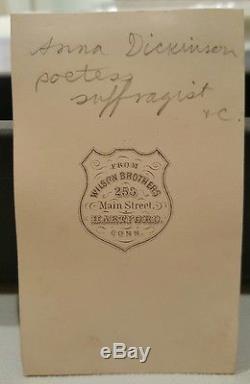


Four original rare CDV photographs measuring approximately 4 x 2 3/8 inches each. When Anna was only two years old, her father died of a heart attack after giving a passionate and influential speech against slavery. She helped support her family from age 15, and in 1861, became one of the federal governments first female employees when she got a job at the U.
She began her activism even earlier, when she was thirteen years old, by writing an essay for William Lloyd Garrisons famed newspaper, The Liberator. She also was friendly with Lucretia Mott, who preached against slavery in Quaker meetinghouses for decades. Unlike others of the eras religions, Quakers encouraged women to speak in public, and under Motts leadership, some eight hundred Philadelphians bought tickets for Dickinsons first major speech early in 1861, The Rights and Wrongs of Women. Dickinson lost her job at the Mint when she publicly criticized Union strategy, and then Mottu arranged a lecture tour for the 19-year-old girl that was sponsored by the Massachusetts Anti-Slavery Society. Her reputation grew so quickly that more than 5,000 people crowded New Yorks Cooper Institute for her first appearance in that city. One newsman wrote that she could hold her audience spellbound for as much as two hours. She gave the impression of being under some magical control. As the Civil War worsened, the new Republican Party hired her to deliver the pro-Union message to audiences that were not especially supportive of the war.Some Pennsylvania coal miners who objected to the draft literally took shots at Dickinson, but she converted many to the abolitionist cause. She also is credited with influencing the people of Connecticut to vote for the man who became governor. Averaging a speech every other day, she earned as much as twenty thousand dollars annually an amazing amount for that era. She reached the high point of her career in 1864, when Republican leaders in Congress invited her to speak. She was the first woman thus honored, and in addition to the president, other military and civilian leaders packed the House floor and its gallery.
At a time when many people still considered it taboo for a woman to speak in public, this was an amazing achievement. It was particularly remarkable for such a young woman to capture the attention of well-informed and busy congressmen. In addition to Lucretia Mott, Dickinson was close to Susan B. Anthony who also was a lecturer and an active Quaker in her youth. Anthony in fact felt such personal fondness for Dickinson that she addressed her in some letters as Chickie Dickie.
She addressed venereal disease in a lecture titled Between Us Be Truth and spoke on polygamy in Whited Sepulchers. Her most popular talk was about Joan of Arc, and some people referred to her as the Civil Wars Joan of Arc. She also published several books, the most radical of which was a novel sympathetic to interracial marriage, What Answer?
Anna Dickinson did not age well, however, and never recovered from her postwar loss of fame. Unlike Anthony, whose popularity rose with age, Dickinsons declined; her speeches in the 1888 presidential election were so excessively partisan and hostile that the Republican Party never hired her again. She tried acting, but was not a hit on the stage, and by 1891, showed such signs of paranoia that she was involuntarily committed to a Pennsylvania hospital for the insane. She filed lawsuits upon her release, was adjudicated sane, and recovered damages from newspapers but the experience shook her self-confidence and ended her career. Fame arguably had come too easily, too early in her life. Although she was a genuine celebrity and an asset to the Union in the Civil War, Anna Dickinson lived the next forty years in the households of friends, unnoticed and unwanted by the public. She died just days before her ninetieth birthday. Taken from Young and Brave: Girls Changing History Works Cited: Chester, Giraud. Embattled Maiden: The Life of Anna Dickinson. Americas Joan of Arc: The Life of Anna Elizabeth Dickinson. Snodgrass, Mary Ellen, in Doris Weatherford, ed. A History of Women in the United States: A State-by-State Reference.The item "ANTIQUE CIVIL WAR ERA ANTI SLAVERY ABOLITIONIST SUFFRAGETTE PA CT NY CDV PHOTOS" is in sale since Sunday, January 29, 2017. This item is in the category "Collectibles\Photographic Images\Vintage & Antique (Pre-1940)\CDVs". The seller is "theprimitivefold" and is located in Villa Park, Illinois. This item can be shipped worldwide.
- Original/Reprint: Original Print
- Listed By: Dealer or Reseller
- Signed?: Signed
- Date of Creation: Pre-1950
- Photo Type: CDV
- Subject: Military & Political
- Color: Sepia
- Framing: Unframed
- Size Type/Largest Dimension: Small (Up to 7")
- Region of Origin: US

